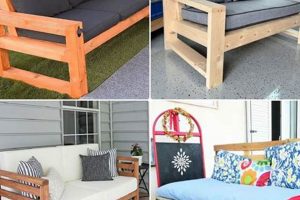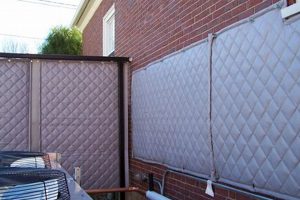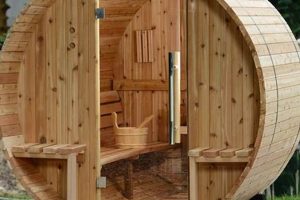Constructing a personalized viewing surface for open-air cinematic experiences involves a do-it-yourself approach to crafting a structure upon which images from a projector can be displayed. This undertaking typically entails selecting materials, assembling a frame, and attaching a reflective or transmissive surface optimized for projected light. An example would be building a frame from PVC pipe and stretching white canvas across it to create a large-format display for backyard movie nights.
The value in creating such a display lies in the cost savings achieved versus purchasing a commercially manufactured unit, alongside the opportunity for customization to fit specific spaces and viewing needs. Historically, makeshift displays have been employed for open-air entertainment, evolving from simple sheets hung on walls to more sophisticated, purpose-built constructions. The rise in popularity of home projectors has fueled the demand for accessible and adaptable viewing solutions.
The subsequent discussion will address key aspects of this process, including material selection, frame construction techniques, surface attachment methods, and considerations for optimizing viewing quality and environmental durability. Various design approaches will be explored, allowing for informed decisions regarding the creation of a suitable display that enhances the outdoor cinematic experience.
Enhancing the Do-It-Yourself Outdoor Projection Experience
The following recommendations are designed to improve the design and construction of a personalized viewing surface for outdoor projection, ensuring an optimal and durable viewing experience.
Tip 1: Frame Material Selection: Employ pressure-treated lumber or PVC piping for the frame construction. These materials exhibit resistance to moisture and environmental degradation, extending the lifespan of the structure. For example, using schedule 40 PVC piping offers a lightweight yet robust framework suitable for various sizes.
Tip 2: Surface Material Consideration: Opt for a matte white or grey projection screen material. These surfaces diffuse light evenly, minimizing glare and hot spots. An example is blackout cloth, commonly used in window treatments, which provides excellent light absorption and a smooth projection surface.
Tip 3: Tension and Wrinkle Management: Secure the projection surface tautly to the frame. Utilize methods such as grommets and bungee cords or a staple gun with appropriate staples to ensure even tension. Insufficient tension results in visible wrinkles that detract from the viewing experience.
Tip 4: Wind Resistance Strategies: Implement methods to secure the structure against wind. This could include anchoring the frame to the ground with stakes or utilizing weighted bases. Failure to address wind resistance can result in damage to the structure or injury.
Tip 5: Aspect Ratio Optimization: Determine the projector’s native aspect ratio and construct the display accordingly. Common aspect ratios include 16:9 (widescreen) and 4:3 (standard). Matching the display’s aspect ratio to the projector eliminates black bars and maximizes screen utilization.
Tip 6: Portability Considerations: Design the structure for ease of disassembly and transport if portability is a requirement. Utilizing modular construction techniques or lightweight materials facilitates movement and storage. This is particularly beneficial for temporary installations.
Tip 7: Light Spill Mitigation: Position the display in an area with minimal ambient light. External light sources degrade image quality. Alternatively, consider using a dark-colored border around the projection surface to absorb stray light and enhance contrast.
By adhering to these recommendations, a durable, visually optimized, and safe outdoor viewing surface can be created. These strategies contribute to a more professional and enjoyable cinematic experience.
The subsequent discussion will shift toward troubleshooting common issues encountered during construction and strategies for maintaining the display’s longevity.
1. Frame Material Rigidity
Frame material rigidity constitutes a primary determinant in the structural integrity and performance of a self-assembled outdoor projection display. The selection of framing materials directly influences the screen’s ability to maintain a flat, stable surface for optimal image projection and resist deformation under varying environmental conditions. Inadequate rigidity compromises image quality and overall longevity.
- Resistance to Wind Load
A rigid frame withstands wind pressure, preventing warping or collapse. High winds exert significant force on large surfaces, necessitating a frame capable of maintaining its shape. For example, a frame constructed from thin-walled PVC piping may bend excessively in moderate winds, causing visible distortions in the projected image. Conversely, a frame fabricated from lumber or thick-walled metal tubing provides superior wind resistance.
- Prevention of Sagging and Warping
Materials lacking sufficient stiffness may sag over time, particularly under the weight of the screen material or in humid conditions. Sagging introduces unevenness into the viewing surface, resulting in geometric distortions. The selection of appropriate materials, coupled with proper joint construction techniques, mitigates this risk. For instance, a frame built without adequate cross-bracing may exhibit noticeable sagging at the center, affecting image linearity.
- Maintenance of Screen Tension
Frame rigidity is crucial for maintaining consistent tension across the screen material. A flexible frame may allow the screen to loosen over time, leading to wrinkles and folds. The tensioning mechanism, whether it involves grommets, springs, or a stretching system, relies on a stable frame to function effectively. A frame that deforms under tension compromises the uniformity of the viewing surface.
- Overall Structural Durability
A rigid frame contributes to the overall durability of the display. It protects the screen material from damage during transport and storage and provides a stable platform for outdoor use. Selecting materials with inherent resistance to impact and environmental factors ensures a longer lifespan. For example, using untreated wood may result in premature decay, weakening the frame and increasing the risk of structural failure.
The relationship between frame material rigidity and the quality of a do-it-yourself outdoor projection setup is direct and significant. The choice of material, construction techniques, and environmental considerations collectively determine the frame’s ability to support the screen, resist external forces, and maintain optimal viewing conditions. Careful consideration of these factors is essential for a successful and long-lasting outdoor cinematic experience.
2. Surface Tension Uniformity
Surface tension uniformity is a critical factor influencing the image quality on a do-it-yourself outdoor projector screen. Uneven tension across the screen surface directly translates to visible distortions in the projected image. This phenomenon occurs because variations in tension create subtle undulations or wrinkles, altering the angle of incidence of light rays and causing localized blurring or stretching of the image. A tightly stretched, uniform surface minimizes these imperfections, resulting in a clearer and more accurate projection.
Achieving consistent tension presents a practical challenge in crafting a self-made viewing surface. The choice of materials for both the frame and the screen itself plays a vital role. A rigid and stable frame is essential to provide a secure anchor for the screen material, preventing sagging or deformation. Methods for attaching the screen material, such as using grommets and bungee cords, or employing a spring-tensioned system, must be carefully implemented to distribute tension evenly across the entire surface. An example would be failing to adequately tension the corners of the material, causing a visible “pulling” effect and image distortion in those areas. Similarly, using inadequate adhesive or stapling unevenly leads to localized tension variations, resulting in blemishes.
In summary, surface tension uniformity is intrinsically linked to the visual performance of a do-it-yourself outdoor projector screen. Maintaining consistent tension requires careful planning, selection of appropriate materials, and meticulous execution of attachment techniques. Addressing potential challenges such as material elasticity, frame stability, and environmental factors such as temperature fluctuations is crucial to achieving a high-quality projected image. The pursuit of uniformity, although demanding, ultimately contributes significantly to the overall enjoyment and effectiveness of the outdoor viewing experience.
3. Environmental Weatherproofing
Environmental weatherproofing constitutes a critical consideration in the design and construction of any do-it-yourself outdoor projector screen. Due to its intended use in open-air environments, the structure is inherently susceptible to damage and degradation from various weather elements. Proper weatherproofing measures are essential to ensure the screen’s longevity, structural integrity, and continued optimal performance.
- Moisture Resistance
Prolonged exposure to moisture, including rain, dew, and humidity, can cause significant damage to both the frame and the screen material. Wood frames are prone to rot and warping, while metal frames can corrode. Screen materials can develop mildew or become stained. Employing pressure-treated lumber, applying waterproof coatings, and selecting water-resistant screen fabrics are essential preventative measures. An example is the use of marine-grade plywood for the frame, which offers superior water resistance compared to standard plywood.
- Wind Load Mitigation
Outdoor projector screens, particularly larger models, are vulnerable to wind damage. Strong gusts can topple the screen, causing damage to the frame, screen material, or surrounding property. Implementing strategies to increase stability, such as anchoring the screen to the ground with stakes or using weighted bases, is crucial. Additionally, the screen’s design should minimize its surface area exposed to the wind. For instance, a screen with a solid back panel will experience greater wind resistance than one with an open framework.
- UV Radiation Protection
Prolonged exposure to ultraviolet (UV) radiation from sunlight can cause fading, discoloration, and embrittlement of the screen material. Certain fabrics are more resistant to UV damage than others. Applying a UV-resistant coating to the screen surface can also extend its lifespan. Selecting a location for the screen that provides some degree of shade during peak sunlight hours can further minimize UV exposure. For example, using a screen fabric specifically designed for outdoor use, which incorporates UV inhibitors, will provide greater protection than a standard indoor screen material.
- Temperature Fluctuation Resilience
Outdoor projector screens are subject to wide temperature fluctuations, which can cause expansion and contraction of the materials. This can lead to warping of the frame, loosening of the screen material, or even cracking of certain components. Selecting materials with low thermal expansion coefficients and employing construction techniques that allow for some degree of movement can mitigate these effects. For instance, using flexible joints in the frame construction can accommodate temperature-induced expansion and contraction without causing stress fractures.
Integrating these weatherproofing considerations into the design and construction of a do-it-yourself outdoor projector screen is paramount to ensuring its durability and long-term functionality. Neglecting these factors can result in premature failure of the screen, rendering it unusable and potentially hazardous. A well-weatherproofed screen provides years of enjoyment and represents a worthwhile investment of time and resources.
4. Portability Versus Stability
The inherent dichotomy between portability and stability represents a fundamental design consideration in the construction of a do-it-yourself outdoor projector screen. The desired degree of portability directly influences the materials selected, the construction techniques employed, and the overall size and weight of the finished product. Prioritizing portability often necessitates compromises in structural stability, and conversely, maximizing stability can significantly impede the screen’s ease of transport and storage. This trade-off requires careful evaluation of the intended use case and the environmental conditions under which the screen will be deployed.
The importance of balancing these competing factors is evident in various design choices. For instance, a smaller, lightweight screen constructed from PVC piping and thin fabric may be easily transported and set up by a single individual, making it suitable for impromptu movie nights in different locations. However, its limited weight and relatively flexible frame render it susceptible to wind and instability on uneven surfaces. Conversely, a larger screen built from heavy-duty lumber and anchored with substantial weights or stakes provides superior stability and wind resistance, making it ideal for permanent or semi-permanent installations. Yet, its considerable weight and bulk necessitate multiple individuals for transport and assembly, limiting its portability. The intended use dictates the appropriate balance; a screen for frequent relocation benefits from lightweight construction and easy disassembly, while a screen intended for a fixed location prioritizes sturdiness and resistance to environmental elements.
The practical significance of understanding this relationship lies in creating a viewing solution that effectively meets specific needs. An ill-considered design, overly focused on either portability or stability, results in a compromised viewing experience. For example, a screen that is easily blown over by a gentle breeze is rendered unusable, despite its portability. Conversely, a screen that is excessively cumbersome to transport and set up negates the benefits of outdoor projection. Therefore, a thorough assessment of the trade-offs between portability and stability, coupled with careful selection of materials and construction techniques, is crucial for creating a functional and enjoyable do-it-yourself outdoor projection setup.
5. Ambient Light Mitigation
Ambient light mitigation constitutes a critical factor influencing the viewing experience on a do-it-yourself outdoor projector screen. The presence of extraneous light sources diminishes image contrast and clarity, degrading the perceived quality of the projected image. Consequently, effective strategies for minimizing ambient light are essential for optimizing visual performance in outdoor settings.
- Location Selection
Choosing a suitable location is paramount in minimizing ambient light interference. Areas shielded from direct sunlight, streetlights, and other artificial illumination sources offer the best viewing conditions. For instance, positioning the screen in a backyard shaded by trees or a building can significantly reduce ambient light levels, enhancing image contrast. Conversely, placing the screen in a brightly lit area negates the benefits of even the most advanced projector and screen materials.
- Screen Material Properties
The reflective properties of the screen material directly impact its ability to perform in the presence of ambient light. Certain materials are designed to reject ambient light, reflecting only the light from the projector back towards the viewer. These ambient light-rejecting (ALR) screens are particularly effective in mitigating the effects of overhead lighting and diffuse sunlight. An example of such a material is a dark gray screen with a specialized optical coating that directs projected light towards the audience while absorbing ambient light from other directions. However, ALR screens typically come at a higher cost than standard white screens, representing a trade-off between performance and affordability.
- Physical Barriers and Shading
Constructing physical barriers or implementing shading techniques can effectively reduce ambient light levels in the viewing area. Using tarps, curtains, or temporary structures to block out unwanted light can significantly improve image quality. For example, erecting a dark-colored fence or hanging dark fabric around the screen can minimize light spill from neighboring properties or passing vehicles. The effectiveness of these barriers depends on their size, placement, and opacity, requiring careful consideration of the light sources in the surrounding environment.
- Projector Brightness and Contrast Ratio
Selecting a projector with sufficient brightness and a high contrast ratio is crucial for overcoming the effects of ambient light. A brighter projector can produce a more vivid image that is less susceptible to washout from ambient light. Similarly, a higher contrast ratio ensures a greater difference between the brightest and darkest parts of the image, improving overall clarity and detail. An example would be choosing a projector with a minimum of 3000 lumens for outdoor use, coupled with a contrast ratio of at least 2000:1, to ensure a viewable image even in moderately lit environments. However, brighter projectors typically consume more power and generate more heat, necessitating careful consideration of these factors.
The effectiveness of ambient light mitigation strategies directly correlates with the quality of the viewing experience on a self-constructed outdoor projector screen. By carefully considering location, screen material properties, physical barriers, and projector specifications, it is possible to create an enjoyable and immersive outdoor cinematic environment, even in the presence of some ambient light. The optimal approach involves a combination of these strategies, tailored to the specific environmental conditions and budget constraints.
Frequently Asked Questions
The following frequently asked questions address common inquiries regarding the construction and implementation of do-it-yourself outdoor projector screens. These responses aim to provide clear, concise, and objective information for informed decision-making.
Question 1: What materials are most suitable for constructing a durable frame for an outdoor projector screen?
Pressure-treated lumber offers robust resistance to moisture and decay, making it a preferred choice for longevity. Alternatively, schedule 40 PVC piping presents a lightweight and weather-resistant option, suitable for smaller screens or temporary installations. Metal framing, while durable, requires rust-proofing to prevent degradation.
Question 2: What type of screen material provides the best image quality for outdoor projection?
Matte white or gray projection screen materials diffuse light evenly, minimizing glare and hot spots. Blackout cloth, commonly used in window treatments, offers excellent light absorption and a smooth projection surface. Ambient light rejecting (ALR) screens are available but may necessitate a higher budget.
Question 3: How can wrinkles and sagging be prevented in a self-made projector screen?
Ensuring uniform tension across the screen surface is crucial. Employ methods such as grommets and bungee cords, a staple gun with appropriate staples, or a spring-tensioned system to achieve even tension. A rigid frame is essential to maintain this tension over time.
Question 4: What strategies mitigate the effects of wind on an outdoor projector screen?
Anchor the screen frame to the ground using stakes, weighted bases, or guy lines. Employing a design that minimizes the surface area exposed to the wind reduces stress on the structure. Consider a design that can be easily disassembled or lowered during periods of high wind.
Question 5: How does one determine the correct aspect ratio for an outdoor projector screen?
The aspect ratio should match the projector’s native resolution to avoid image distortion or black bars. Common aspect ratios include 16:9 (widescreen) and 4:3 (standard). Consult the projector’s specifications to determine the correct aspect ratio and construct the screen accordingly.
Question 6: What are the best methods for minimizing the impact of ambient light on outdoor projection?
Select a location with minimal ambient light, such as a backyard shielded from streetlights. Employ a screen material with ambient light rejection properties. Utilize physical barriers, such as tarps or curtains, to block out extraneous light sources. A projector with high brightness and contrast ratio can help overcome ambient light.
These frequently asked questions provide a foundation for understanding key considerations in creating a do-it-yourself outdoor projector screen. Addressing these factors contributes to a more successful and enjoyable outdoor cinematic experience.
The subsequent discussion will address potential challenges encountered during construction and strategies for ensuring the display’s maintenance over an extended period.
Concluding Remarks
The preceding analysis has elucidated critical considerations for constructing a viewing surface suitable for open-air projection. From material selection to weatherproofing strategies and ambient light mitigation techniques, the information presented aims to equip individuals with the knowledge necessary to create a functional and durable viewing display. Successful implementation hinges on meticulous planning, careful execution, and a thorough understanding of the environmental factors influencing performance.
The decision to pursue a self-constructed viewing solution requires a commitment to detail and a willingness to adapt to unforeseen challenges. The value derived from such an undertaking extends beyond mere cost savings, encompassing the satisfaction of creating a personalized entertainment experience. Continued innovation in materials and construction methods promises to further refine the capabilities and accessibility of outdoor projection technology, ensuring its continued relevance in the realm of home entertainment. The ongoing exploration of these techniques is essential for realizing the full potential of the outdoor cinematic experience.







